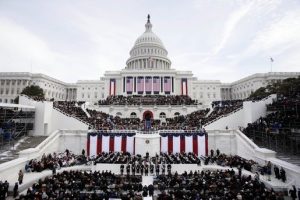 Every four years Washington gets to shine as host of one of the most meaningful events for democracies world-wide - the Presidential Inauguration. The first Presidential Inauguration in Washington, DC, took place in 1801 with the swearing in of Thomas Jefferson. After his second inauguration, Jefferson rode on horseback from the Capitol to the President's House "amid music and a spontaneous gathering of mechanics from the nearby Navy Yard." This spontaneous celebration was the birth of the inaugural parade.[Tweet "A superlative look at past Presidential Inaugurations #GovEventsBlog #Inauguration2017"]
Every four years Washington gets to shine as host of one of the most meaningful events for democracies world-wide - the Presidential Inauguration. The first Presidential Inauguration in Washington, DC, took place in 1801 with the swearing in of Thomas Jefferson. After his second inauguration, Jefferson rode on horseback from the Capitol to the President's House "amid music and a spontaneous gathering of mechanics from the nearby Navy Yard." This spontaneous celebration was the birth of the inaugural parade.[Tweet "A superlative look at past Presidential Inaugurations #GovEventsBlog #Inauguration2017"]
Today's inaugurations are, of course, much less impromptu. The Joint Congressional Committee on Inaugural Ceremonies (made up of members of both parties from the House of Representatives and the Senate) and the Presidential Inaugural Committee have been planning the event for months. Planning for building the platform in front of the Capitol takes one year alone. In addition to logistics, these groups must raise funds to cover a portion of the estimated $175 to 200 million price tag for the events. The largest line items in the overall budget are security, transportation, and clean-up efforts.[Tweet "Largest #inauguration expenses are security, transportation, and clean-up. #GovEventsBlog"] Private companies also work to make sure logistics are seamless for this massive event. Verizon announced they will increase their" data network capacity by 500% on January 20th to accommodate the large crowd's bandwidth needs and to ensure first responders are supported.
January 20th was set as Inauguration Day by the 20th amendment in 1933. Before that, the formal transfer of power took place on March 4th to commemorate the day on which the Constitution first took effect. The four month gap was needed to tally votes by hand and for the incoming President to physically make the trip to Washington. The amendment was introduced once that gap was no longer needed and in an effort to close the lame-duck period of the outgoing President.
With that amendment, only the date and the words of the oath are set in our Constitution. Everything else is simply tradition and is subject to change depending on the preference of the President. From walking the parade route to speech length to the ball, how the incoming President decides to celebrate and participate often speaks to his beliefs and general tenor. For example, Andrew Jackson opened the White House to the public in an effort to share the office with the people. It had disastrous consequences with a near riot breaking out in the large crowds that trashed the White House. In a quieter move, Abraham Lincoln invited African Americans to march in the Inaugural Parade for the first time in 1865.[Tweet "Only date and words of the oath are set in our Constitution. #GovEventsBlog #Inauguration2017"]
Over time, this flexibility has led to a wide range in the celebration of the peaceful transfer of power. As the 2017 inauguration approaches, we were inspired to take a superlative look at Presidential Inaugurations past:
- Shortest Inaugural Address - George Washington (135 words)
- Longest Inaugural Address - William Henry Harrison (100 minutes and 8,495 words)
- Deadliest Inauguration - William Henry Harrison (eschewing an overcoat and talking for 100 minutes, Harrison caught pneumonia and died a month later)
- Largest Attendance - Barack Obama (1.8 million people in 2009)
- Coldest Inauguration - Ronald Regan 1985 (Noon temperature: 7 degrees. The inauguration was moved indoors)
- Warmest Inauguration - Ronald Reagan (1981 Noon temperature: 55 degrees).
- First Inaugural Ball - James Madison (with his wife Dolley were the Guests of Honor at Long's Hotel in Washington, D.C.)
- First Official Inauguration Photograph - James Buchanan (1857)
- First Televised Inauguration - Harry Truman (1949)
Any inauguration insights we missed? Let us know in the comments.



